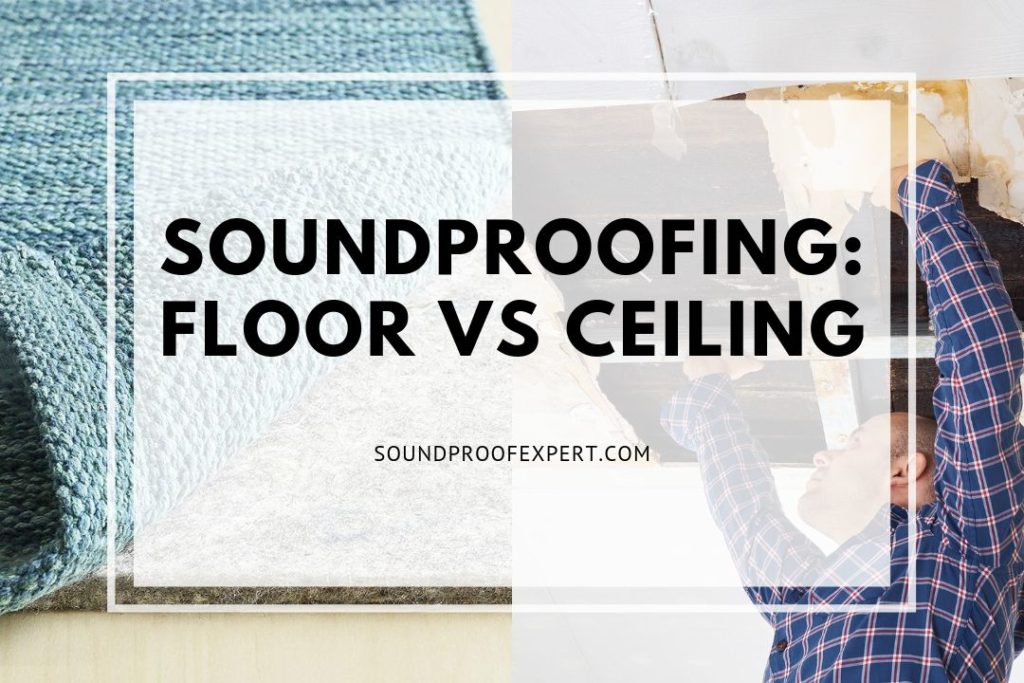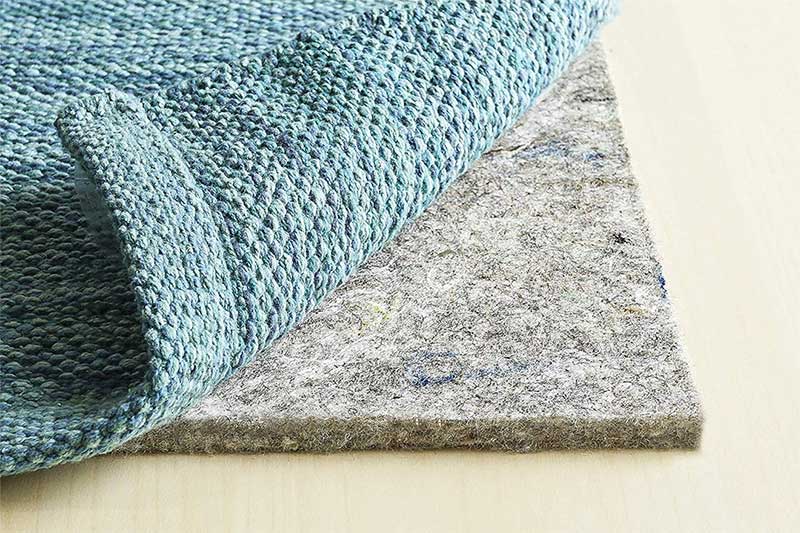
No matter where you live, whether it is an apartment, two story home, or even a one story home, there may come a time where you will need to soundproof a room.
Soundproofing can do two different things, it can keep sound from coming in, and it can keep sound from escaping.
You can soundproof walls, floors, and ceilings of a room, but today, we are going to focus on the floor and ceiling.
So which is better, soundproofing the floor or soundproofing the ceiling?
The best choice for soundproofing a room is going to depend on what your end goal of the room is. If you are trying to reduce the echo of a room or prevent sound from traveling to a neighbor or downstairs room, soundproofing the floor may be the best choice. If you have loud upstairs neighbors or want to ensure your noises aren’t disturbing them, you can look at soundproofing the ceiling.
Soundproofing Your Floor
One of the biggest reasons most people soundproof a floor is to keep sound from traveling from their room to a room below them both in a multistory home and apartments.
Sounds can be categorized into two basic categories – impact and airborne. When it comes to floors, impact is usually the biggest concern as dropping items onto a wooden floor or having someone run across the floor can cause your downstairs neighbors to go crazy.
In this case, you will want to make sure that your floor is as soundproof as possible.
If you have loud downstairs neighbors whose music or appliance’s sounds make their way through the floor, looking at ways to block this airborne noise usually results in similar tactics as impact noises.
Let’s look at a few ways to soundproof your floor to help give you and your neighbors a better living experience.
Acoustic Underlayment
For those with wooden floors, you know just how loud both airborne and impact noises can be not only for you, but downstairs neighbors as well.
While most real wood floors can absorb sound better than laminate wood floors, there is still room for improvement to get the best soundproofing available.
This requires adding acoustic underlayment (click to see my recommendation on Amazon) under the wood floor, a job best left to professionals or highly experienced DIYers.

Acoustic underlayment is usually found as a sort of foam padding that will be installed between your subfloor and the wood flooring.
This underlayment helps to absorb more noise from both impact and airborne sounds and can help to provide more cushion to your existing floor.
This is not going to be the best solution, but it can make a big impact on your current flooring situation.
Carpet Padding
When it comes to flooring materials, carpet is one of the most effective when absorbing sound.
Much like acoustic underlayment, carpet padding (click to see my recommended carpet padding on Amazon) installs between the subfloor and the carpet to provide a cushion below the carpet and an extra layer of material that sound will have to travel through before reaching the next room.

The natural characteristics of carpet allow sound to be dampened before traveling through a floor. With that being said, there is still room for improvement, and adding a layer of carpet padding can help increase the soundproofing ability of carpet.
If you are experienced with removing and installing carpet, this could be an easy project for you, however, I highly suggest having a professional install your carpet padding.
Adding Rugs
Not all floors are going to need a serious revamp to help to block sound. Since many of the above solutions requires a larger budget, I wanted to add in a more budget friendly solution that can help to add some aesthetics of your room as well.

Simply adding rugs to a room can help to absorb some sound, especially if placed in an area where more of your impact sounds are coming from.
For example, if you have kids that run throughout the house, adding a long rug in the pathway of their running can seriously reduce the impact noise given off by your kids. This is a great way to reduce noise and upgrade the looks of just about any room without breaking the bank.
Interlocking Floor Mats
Soundproofing your floor does not have to be as hard as it may seem, in fact, there is a simple solution that just about anyone can do to make their floor more soundproof.
That method involved installing interlocking floor mats on your floor.

These foam tiles are usually found in a square shape with interlocking tabs on each side which allow you to easily place them where you need them and simply push the tabs into place. They are easily cuttable and can be removed with ease with no damage done to your current flooring.
This is a great solution for those who are renting or do not want to remove their floor to install underlayment. The foam tiles make a great addition to a gym as they absorb impact noises.
You can find them in all sorts of colors, even fun patterns if you choose to add them to your child’s playroom. When used in kids rooms, they can both soundproof the floor and keep them safe if your child falls on the floor.
Also see my articles on the topic:
5 Ways To Soundproofing a Wooden Floor
How To SoundProof An Attic Floor (Effectively)
Soundproofing Your Ceiling
Much like a floor, impact and airborne sounds can be reasons that you would want to soundproof your ceiling.
If you have a loud family, listen to your TV or music loudly, or simply have loud pets, soundproofing your ceiling can help upstairs neighbors or family members in upper level rooms enjoy their peace and quiet.
If you have noisy neighbors above you who are constantly dropping things on the floor or walk with a heavy foot, soundproofing your ceiling can help mask some of the noises coming from upstairs residents.
Today we are going to look at a few different ways to soundproof your ceiling to help you block some of these annoying noises.
Types Of Ceilings
Before we can get into specifics of soundproofing your ceiling, we must look at and understand the different types of ceilings you will commonly see in most homes and office buildings.
The industry standard for most home ceilings is drywall which has a pretty decent soundproofing capability. For most offices, you are going to find drop ceilings, which are the foam tiles you see in many business buildings.
When taking a closer look at each one, you can easily decide which will be best for your application for both aesthetics and soundproofing capabilities.
Drywall Ceiling
Drywall ceilings are the most common ceilings in homes across the world. Drywall is easy to install, relatively cheap, and can be painted to your desire, cut to fit lights, and modified to fit vaulted ceilings.
While drywall is one of the most common ceiling materials, it is not the best option if you are looking for maximum soundproofing.
The flat surface of the drywall that is mounted to the studs can allow sound to travel through it quite easily.
To get the most out of your drywall ceiling, you will have to use various methods, which we will discuss later on, to maximize the soundproofing potential.
Drop Ceiling
Drop ceilings are most commonly found in offices and gyms where soundproofing is a must.
Drop ceilings are comprised of a railing system that is suspended from the building’s ceiling frame and holds foam tiles which help to absorb sound and can be cut to fit lights and other fixtures.
Drop ceilings are one of the best ways to soundproof a room without having to add additional materials.
This type of ceiling may not look as aesthetically pleasing as painted or textured drywall, but it does look very uniform and provides great soundproofing for any room. This would be an ideal ceiling material for a sound studio, gym, or other rooms with louder noises.
Double Up On Drywall
Since drywall is one of the most commonly found ceiling materials in just about any homes, one of the easiest solutions to soundproof a room is to simply add another layer of drywall.
An extra layer of drywall can give you twice the amount of soundproofing without having to tear out any existing drywall.
This is a common practice in soundproofing rooms as it is budget friendly, relatively easy, and can be done by just about anyone.
This allows you to keep the same great looks as you had before without worrying about adding new joists, foam panels, or other heavy construction.
Acoustic Foam Panels
Acoustic foam panels are a standard when it comes to soundproofing any room. If you have ever seen a music studio, you have most likely seen these types of panels on the walls or on the ceiling.
These acoustic foam panels help to absorb sound and can be found in just about any shape, size, or color to fit the theme of your room.
Adding these tiles to your ceiling can drastically reduce the amount of sound escaping your room. With that being said, you are going to want to use these tiles for rooms where you do not want sound to travel out of.
Floating Joists
One of the most involved ways to help soundproof your room is to install floating joists on your existing ceiling joists. This is a method that is best left to the professionals as it will require you ripping out the existing drywall if you are not doing this during a new construction build.
Ceiling joists run across your ceiling and act as a mounting surface for the ceiling drywall.
When sound travels, it will travel through materials, so having the drywall mounted to the joists which are mounted to the floor above you will cause sound to easily travel back and forth.
Floating joists requires adding new joists that are mounted halfway down the existing joists to allow them to hang lower and provide a surface where the joists will not contact both the ceiling and the floor above it, reducing the sound that travels between them.
Use Green Glue
Last but not least, you can use green glue when attaching any materials such as an extra layer of drywall to help dampen sound.
Green glue is an acoustic adhesive that does a great job on reducing the vibrations that travel through the drywall material.
After all, sound is merely vibrations and reducing any of this vibration can seriously help. Green glue can easily be applied by the most inexperienced DIYer and is relatively inexpensive.
It is used by professionals in various applications.
Hiring A Professional
If you are not the DIY type and want to get your floor as soundproof as possible, it may be in your best interest to hire a professional.
Professional soundproofing companies have teams of experienced sound technicians who have special tools to measure the sounds emitted in and around your room.
Using these tools, they will be able to figure out the best solution for your floor to maximize the soundproofing abilities.
For those who have an idea of what they need done, such as underlayment or acoustic foam panels, simply hiring a professional flooring company should suffice.
A professional will be able to remove your current flooring and install the needed soundproofing material and reinstall the flooring so that you never have to lift a finger. All you have to do is sit back and enjoy your peace and quiet.
Conclusion
Now that I have discussed the various options when it comes to soundproofing your floor and ceiling, you should be able to figure out which is going to be best for your specific situation.
Soundproofing is all about reducing the sound coming into or out of a room, so remember to really understand your main goal of your soundproofing before diving into your project.
Have you soundproofed a room before? What materials worked best for you? Are there any other supplies or methods that you would suggest when soundproofing a room?

Hi Jim, I have these sound dampening pads, one 1/8” “green” felt, the other 1/8” thin rubber. They are usually used for flooring underlayment. I’m stapling them to my drywall ceiling. The drywall ceiling is attached to the joists via those metal decouplers. Then on top of the underlayments, I’m putting a 1×4 grid pattern. I’m thinking it’s safer to screw these through to the joist, rather than increasing the load on the metal decouplers (and not sure how successful I would be in hitting those narrow rails with my screws). Then I’m glueing down and nailing 3/8” plywood sheets, leaving small reveals.
It should look great, but I’m wondering how much sound I’m going to dampen from the upstairs neighbours? I realize that mass loaded vinyl is abetter option, but I got these underlayments for only $20!
Hi in one bedroom apt. Upstairs very. Heavy footsteps always dropping hard objects what material will quell bedroom first 20′ by 16ft’ give quote
Hi Jim, Thanks for the info. Do you have any recommendations for Marin County near the SF Bay Area please ? Franci